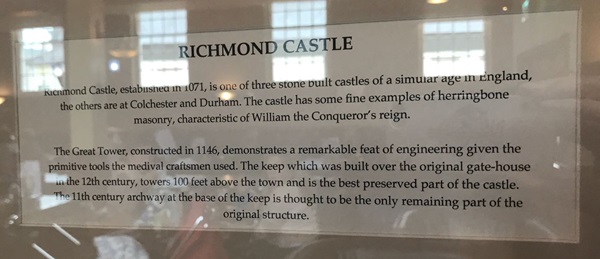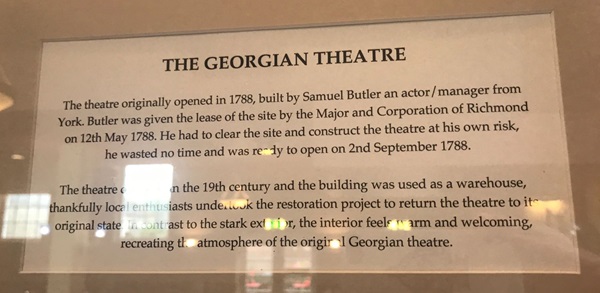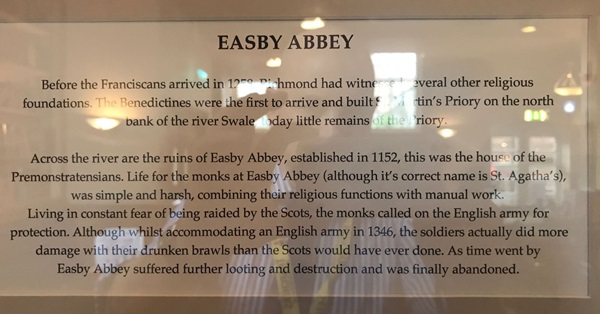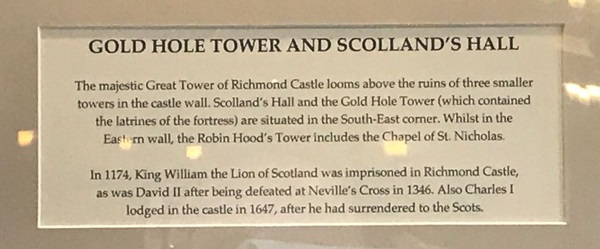This former post office faces Friary Gardens which recall the friary founded by Ralph Fitz Randall in the late 13th century. After his death, Fitz Randall’s heart was buried at the friary in a silver casket.
Text about the Market Place.

The text reads: Richmond is a unique town, its features today are all part of the original design and include a spacious cobbled market place, narrows wynds and the old fortified ruins. On the island in the middle of the Market Place, stands the twice restored Holy Trinity Church, which has shops beneath the north aisle. Richmond feels almost continental in places and has been likened to the old city of Toledo, in Spain.
Text about Richmond Castle.

The text reads: Richmond Castle, established in 1071, is one of the three stone built castles of a similar age in England, the others are at Colchester and Durham. The castle has some fine examples of herringbone masonry, characteristic of William the Conqueror’s reign.
The Great Tower, constructed in 1146, demonstrates a remarkable feat of engineering given the primitive tools the medieval craftsmen used. The keep which was built over the original gate-house in the 12th century, towers 100 feet above the town and is the best preserved part of the castle. The 11th century archway at the base of the keep is thought to be the only remaining part of the original structure.
Text about the Georgian theatre.

The text reads: The theatre originally opened in 1788, built by Samuel Butler an actor/manager from York. Butler was given the lease of the site by the Major and Corporation of Richmond on 12 May 1788. He had to clear the site and construct the theatre at his own risk, he wasted no time and was ready to open on 2 September 1788.
The theatre closed in the 19th century and the building was used as a warehouse, thankfully local enthusiasts undertook the restoration project to return the theatre to its original state. In contrast to the stark exterior, the interior feels warm and welcoming, recreating the atmosphere of the original Georgian theatre.
Text about Easby Abbey.

The text reads: Before the Franciscans arrived in 1258, Richmond had witnessed several other religious foundations. The Benedictines were the first to arrive and built St. Martin’s Priory on the north bank of the river Swale, today little remains of the Priory.
Across the river are the ruins of Easby Abbey, established in 1152, this was the house of the Premonstratensians. Life for the monks at Easby Abbey (although its correct name is St. Agatha’s), was simple and harsh, combing their religious functions with manual work. Living in constant fear of being raised by the Scots, the monks called on the English army for protection. Although whilst accommodating an English army in 1346, the soldiers actually did more damage with their drunken brawls than the Scots would have ever done. As time went by Easby Abbey suffered further looting and destruction and was finally abandoned.
Text about Gold Hole Tower and Scolland’s Hall.

The text reads: The majestic Great Tower of Richmond Castle looms above the ruins of three smaller towers in the castle wall. Scolland’s Hall and the Gold Hole Tower (which contained the latrines of the fortress) are situated in the south-east corner. Whilst in the eastern wall, the Robin Hood’s Tower includes the Chapel of St. Nicholas.
In 1174, King William the Lion of Scotland was imprisoned in Richmond Castle, as was David II after being defeated at Neville’s Cross in 1346. Also Charles I lodged in the castle in 1647, after he had surrendered to the Scots.
External photograph of the building – main entrance.
.jpg?h=570&&w=600&la=en&hash=9608F8438E6E183B5CDDE4E419F9E6E45C6F60BC)
If you have information on the history of this pub, then we’d like you to share it with us. Please e-mail all information to: pubhistories@jdwetherspoon.co.uk